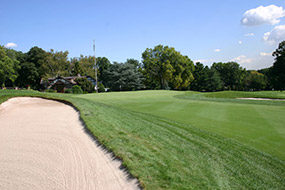Established by a New York socialite in the mid-1890s, the Baltusrol Golf Club is located a short drive west of Manhattan and set in the foothills of a northern New Jersey mountain. Although the club’s original course was a primitive nine-holer, it quickly expanded to eighteen holes and was soon of sufficient standard to host numerous national championships. By 1918, however, growing demand for tee times had forced the club to look at building a second layout, with prominent architect A.W. Tillinghast hired to do the design work.
Unimpressed by the existing course, Tillinghast rather boldly suggested the club would be better off abandoning it entirely and instead building 36 brand new holes. Surprisingly they agreed, and the designer set about routing his two layouts across the site, setting the Upper Course partly into the base of the mountain and arranging the Lower holes down on the flatter valley floor. While both courses were essentially new, Tillinghast did incorporate several existing green sites into his design.
Despite lacking the dramatic terrain of the Upper holes and being a little too heavily treed, the more uniformly demanding Lower Course has plenty of tournament pedigree and is the course that visitors most want to play. Not surprisingly, its best holes are those built across the subtle undulations, the first significant hole being the 2nd, a mid-length par four whose narrow, rising fairway is cut by an expanse of sand and whose steeply leaning green is protected by eight nasty traps. The 3rd is another undulating beauty, this time sweeping down and left through tall trees and featuring a demanding approach played across a creek toward a large, angled green guarded by deep bunkers. Elsewhere, attractive elevated green sites at the 5th and 15th are quite impressive as are approach shots into adjacent targets at the 6th and 14th and the tricky par four 13th, which bends along a rerouted creek. Across the rest of the course, holes are mainly noted for relentlessly narrow landing areas, creative bunker arrangements and tight green complexes.
The Upper Course, by contrast, is shorter and more open and starts by heading along the base of the hills before settling onto the flatter ground beside the Lower holes. The layout is best recommended for early side-hill holes like the par three 3rd, said to be an original from the 1895 design, and the steeply benched right-to-left green on the split-fairway 4th. On the lower areas, raised targets at the 10th, 12th and 13th standout as does the par four finishing hole, rolling uphill toward a green site placed beyond a small saddle and pinched between sand.
Baltusrol has tried as hard as any club to combat modern technology, and since Tillinghast’s passing both courses have been changed substantially, if not structurally. During the 1940s Robert Trent Jones added 400 yards, and countless fairway bunkers, to the Lower Course in an effort to attract major championship play back to the club. During the ensuing years, they have continued to toughen their holes by adding more back tees, encouraging even denser roughs and allowing trees to grow and intrude even farther into the line of play.
Although neither layout here is world-class, Baltusrol is an outstanding golf club and the opportunity to play at such a revered venue, and on such demanding holes, will be a tremendous attraction to many golfers.

 this course also has exceptional:
this course also has exceptional:
